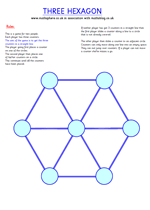Playing board games and card games from an early age is a great way to help children with their maths. Whether it is matching pairs, counting on or back or throwing dice, the participation involves calculating skills, predicting, seeing patterns and thinking logically.
Here we have a great little maths game for young children, thanks to MathSphere from its CD, ‘It’s All Figured Out!’
The rules are as follows:
This is a game for two people.
Each player has three counters.
The aim of the game is to get the three counters in a straight line.
The player going first places a counter on one of the circles.
The second player then places one of his/her counters on a circle. This continues until all the counters have been placed.
If neither player has got 3 counters in a straight line then the first player slides a counter along a line to a circle that is not already covered.
The other player then slides a counter to an adjacent circle. Counters can only move along one line into an empty space. They can not jump over counters.
If a player can not move a counter she/he misses a go.
Is there an advantage in going first? By careful placement of the counters at the start of the game can you ensure that you will always win?

nice